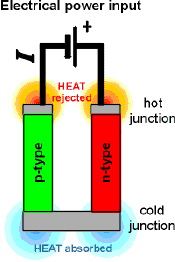Active Building Envelope from Rennselaer
 Every day, the sun bathes the planet in energy--free of charge--yet few systems can take advantage of that source for both heating and cooling. Now, researchers are making progress on a thin-film technology that adheres both solar cells and heat pumps onto surfaces, ultimately turning walls, windows, and maybe even soda bottles into climate control systems. On July 12, 2006, Rensselaer Polytechnic Institute (RPI) researcher Steven Van Dessel and his colleagues will announce their most recent progress--including a computer model to help them simulate the climate within their test structure atop the RPI Student Union--at the Solar 2006 Conference in Denver, Colo. For 4 years, the researchers have been working on their prototype Active Building Envelope (ABE) system. Comprised of solar panels, solid-state, thermoelectric heat pumps and a storage device to provide energy on rainy days (literally), the ABE system accomplishes the jobs of both cooling and heating, yet operates silently with no moving parts. NSF is supporting the team to determine if a microscale version of the technology will function effectively. According to Van Dessel, thin-film advances could potentially lead to functional thermal coatings composed of transparent ABE systems. Such systems might vastly improve the efficiency of temperature-control systems. "The ease of application would make it possible to seamlessly attach the system to various building surfaces," he added, "possibly rendering conventional air conditioning and heating equipment obsolete."
Every day, the sun bathes the planet in energy--free of charge--yet few systems can take advantage of that source for both heating and cooling. Now, researchers are making progress on a thin-film technology that adheres both solar cells and heat pumps onto surfaces, ultimately turning walls, windows, and maybe even soda bottles into climate control systems. On July 12, 2006, Rensselaer Polytechnic Institute (RPI) researcher Steven Van Dessel and his colleagues will announce their most recent progress--including a computer model to help them simulate the climate within their test structure atop the RPI Student Union--at the Solar 2006 Conference in Denver, Colo. For 4 years, the researchers have been working on their prototype Active Building Envelope (ABE) system. Comprised of solar panels, solid-state, thermoelectric heat pumps and a storage device to provide energy on rainy days (literally), the ABE system accomplishes the jobs of both cooling and heating, yet operates silently with no moving parts. NSF is supporting the team to determine if a microscale version of the technology will function effectively. According to Van Dessel, thin-film advances could potentially lead to functional thermal coatings composed of transparent ABE systems. Such systems might vastly improve the efficiency of temperature-control systems. "The ease of application would make it possible to seamlessly attach the system to various building surfaces," he added, "possibly rendering conventional air conditioning and heating equipment obsolete."Source
Here is more information on the ABE system from Physorg
Thermoelectric heating, cooling, and electrical generation, are ways in which sunshine can be used directly for temperature control and power production. Van Dessel and the Rennselaer team are dedicated to integrating this powerful technology into all new construction. The team has made a great deal of progress in the past three or four years, in miniaturizing the technology, converting it into a thin film. Eventually, molecular scale coatings will probably accomplish the same hat trick.
Labels: heat storage

0 Comments:
Post a Comment
Subscribe to Post Comments [Atom]
<< Home